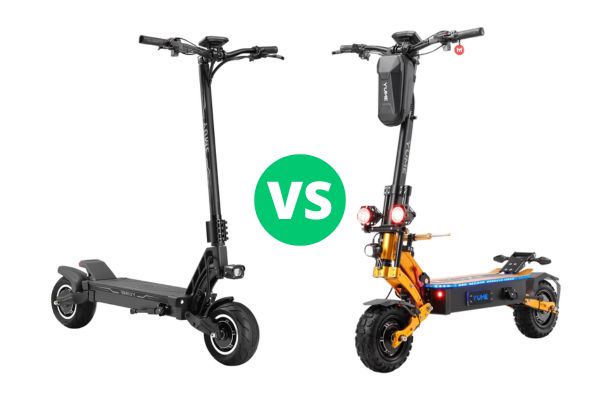The YUME Hawk Pro and the YUME X11+ may look similar on paper. Both scooters have a massive 6000W peak power output and promise speeds of up to 50 MPH. They even use similar battery options. But when you look deeper, you’ll see that they are very different machines built with different ideas in mind. The Hawk Pro is designed more for sleek road use, while the X11+ is made for stability across all types of terrain.
However, there’s a bigger issue here: YUME’s overall build quality and reliability. While the specs might sound great, real-world users have often reported problems straight out of the box. These scooters demand that the rider be hands-on. Whether it’s tightening loose bolts or fixing electrical issues, YUME buyers often become their own mechanics.
This article breaks down the real differences between these two scooters. From how they perform to what users actually experience, we’ll explore it all. You’ll also find a detailed buyer’s guide to help you stay safe and maintain the scooter long-term.
YUME Hawk Pro vs X11+ Plus
Before diving into how these scooters feel on the road, it’s important to understand their specs. Both scooters offer similar stats when it comes to motor power, top speed, and range. However, the way they ride is totally different.
YUME Hawk Pro vs YUME X11+ Plus Specification Comparison
| Feature | YUME Hawk Pro | YUME X11+ |
| Price (Sale/Regular) | ~$1,340 (sale) | $1,469 / $2,399 |
| Motor Power (Peak) | 6000W (2 x 3000W) | 6000W (2 x 3000W) |
| Top Speed | Up to 50 MPH | Up to 50 MPH |
| Battery Options | 60V 27Ah / 60V 30Ah (Samsung) | 60V 27Ah / 60V 30Ah (Samsung) |
| Battery Energy | 1620Wh / 1800Wh | 1620Wh / 1800Wh |
| Claimed Range | 56–60 miles | 56–60 miles |
| Controllers | 6 MOSFET 45A sine wave | 12 MOSFET 45A sine wave |
| Charging Time | 6–7 hours | 7–8 hours |
| Suspension | Adjustable Hydraulic (Front & Rear) | C-shaped Hydraulic Front / Dual Spring Rear |
| Brakes | ZOOM Hydraulic + EBS | ZOOM Hydraulic + EBS |
| Tires | 10×4.5” Road | 11×3.95” All-Terrain |
| Weight | 90 lbs (41 kg) | 98 lbs (45 kg) |
| Max Load | 280 lbs | 330 lbs |
| Waterproof Rating | IP54 | IP54 |
| Key Features | NFC, App, Dual Throttle | NFC, App, Dual Throttle |
| Accessories | Phone holder, mirrors, steering dampener | Front bag, phone holder, mirror, dampener |
Pros and Cons
| Scooter | Pros | Cons |
| YUME Hawk Pro | – Strong acceleration- Good looks- Comfortable deck- Extra accessories included | – Dangerous high-speed handling- Weak braking- Needs repairs before first ride- Inconsistent build quality- Heavy and awkward to move |
| YUME X11+ | – Very stable- Great for rough terrain- Widely preferred by users- High power-to-price ratio | – Still has QC issues- Rattling rear fender- Very heavy at 98 lbs |
Propulsion System Analysis
Both scooters are packed with the same powerful dual-motor setup, two 3000W brushless motors, one in each wheel. This means you’re getting serious acceleration and top-end speed. The motors are controlled by sine wave controllers, which give smoother, quieter, and more refined power delivery compared to older square wave systems.
But here’s the catch: the X11+ has controllers with 12 MOSFETs while the Hawk Pro only has 6. More MOSFETs help the controller manage heat better, which means fewer failures during long or intense rides. So while both scooters promise similar performance, the X11+ has a slight edge in long-term reliability.
Battery and Endurance Deep Dive
The battery setup is also nearly identical. Both offer a standard 60V 27Ah pack or a premium 60V 30Ah Samsung battery. These premium cells are better because they hold a charge longer and perform more consistently under stress.
While YUME claims up to 60 miles of range, real-world use, especially with dual motors and fast speeds, brings that down to around 30–35 miles. Both models come with a smart Battery Management System (BMS) to prevent overcharging, overheating, and other battery-related problems. Plus, they support dual chargers for quicker recharge times.
The Great Divide: Suspension, Geometry, and Ride Dynamics
Here’s where the real difference lies: how these scooters ride. The Hawk Pro might sound like the better choice with fully adjustable hydraulic suspension, but users report that it’s unstable and unsafe at higher speeds. On the other hand, the X11+ uses a simpler suspension design, but it offers a much more stable and confident ride.
Suspension Philosophy: Adjustable Hydraulic vs. C-Type Spring
The Hawk Pro’s adjustable hydraulic shocks allow you to fine-tune how the scooter handles bumps and speed. It’s a cool feature, but if it’s not designed well, and many users say it’s not, it can do more harm than good.
The X11+ has a more basic setup: a C-shaped hydraulic spring up front and dual springs in the back. This type of system is more common and well-tested. It may not be fancy, but it works, and most importantly, it feels stable when riding.
Rake, Trail, and the Stability Question
This section gets into scooter geometry. The Hawk Pro has a steep rake and almost no trail. These are technical terms, but in simple words, the scooter doesn’t steer itself back to center when you ride. Instead, it feels twitchy and unstable.
The problem gets worse with the Hawk Pro’s wide, flat-profile tires. These tires resist leaning and tend to follow every little bump or groove in the road. Combine this with the flawed geometry, and you’ve got a scooter that can feel dangerous above 30 MPH.
In contrast, the X11+ has more traditional geometry and narrower tires with rounded profiles. This means the steering naturally centers itself, and the ride is much more stable, even at full speed.
Tires, Frame, and Ergonomics
The Hawk Pro’s tires are built for road use but contribute to its instability. Meanwhile, the X11+’s all-terrain tires work well on a variety of surfaces and help absorb shocks better.
Both scooters use the same grade of aluminum in their frame. The Hawk Pro is marketed as having a one-piece molded frame, which may be stronger. Its deck is also wider and more comfortable for foot placement. But even with this advantage, the poor steering geometry overshadows it.
The YUME Dilemma: A Critical Look at Reliability and Brand Trust
YUME scooters look amazing on paper, but the real-world story is different. Many users report problems right out of the box. Some parts arrive loose or broken. Some scooters don’t even power on properly. In short, the company has a serious quality control issue.
A Pattern of Problems: Synthesizing User Feedback
Here are the most common complaints from real users:
- Brake issues: Misaligned brake pads, poor stopping power, or calipers falling off.
- Frame problems: Broken welds and parts snapping mid-ride.
- Electrical faults: Dead-on-arrival units, lights not working, or random power cutouts.
- Loose parts: Screws, bolts, and wires that need tightening or adjustment immediately.
These aren’t rare cases. They are so common that most buyers expect to do at least some fixing before riding.
Customer Service Under Scrutiny
If something does go wrong, YUME’s customer support may not help much. Many users say that they were ignored or told to fix the problems themselves, even if the scooter was brand new. This makes owning a YUME scooter risky unless you’re comfortable working on it yourself.
UL Certification: What It Really Means
YUME advertises that their scooters are “UL Tested,” which sounds great. But UL 2272 only covers electrical safety like battery fires or short circuits. It doesn’t check for frame strength, suspension safety, or steering geometry. So while it’s good to have, it’s not the full safety guarantee some might assume.
The Complete Ownership Guide: From First Ride to Long-Term Maintenance
If you choose to buy a YUME scooter, you’ll need to treat it like a DIY project. Below are some crucial steps to stay safe.
The Critical Pre-Ride Checklist
- Check Every Bolt: Tighten all screws and nuts, especially brakes and suspension parts.
- Set Tire Pressure: Inflate tires to the correct PSI.
- Test Brakes: Make sure brake levers feel firm and stop the scooter effectively.
- Check Folding Mechanism: Ensure it locks securely without any wobble.
- Test Electrical Features: Make sure lights, throttle, display, and other systems work.
- Configure Settings: Use kick-start mode and turn off cruise control for beginners.
- Wear Proper Gear: Always wear a full-face helmet and pads. These scooters are not toys.
Routine Maintenance and Care
- Battery: Don’t drain it completely. Keep it at about 75% when stored.
- Brakes: Check for wear, fluid levels, and bleeding if needed.
- Lubricate: Grease the folding parts and suspension.
- Clean Safely: Use a cloth, not water spray, to clean the scooter.
Upgrades and Parts Availability
Many owners upgrade their scooters for safety and comfort. Popular changes include:
- Better brake pads
- More comfortable grips
- Higher quality tires
Parts are available from YUME or third-party sellers online.
Troubleshooting: Understanding Error Codes
Knowing basic error codes can help you fix common issues:
- Error 06: Low battery – recharge.
- Error 07: Motor issue – check wiring.
- Error 08: Throttle issue – may need replacing.
- Error 09: Controller issue – usually means a replacement.
- Error 10/11: Communication fault – check cables.
Final Verdict and Recommendations
YUME Hawk Pro
The Hawk Pro has major problems with stability that are tied to its design. This isn’t just a flaw, it’s a safety risk. Unless you are an expert rider and mechanic planning to rebuild the front end, it’s best to avoid this model.
YUME X11+
The X11+ is far more stable and better built. It still suffers from YUME’s quality control problems, but its design is fundamentally sound. If you are prepared to do your own checks, maintenance, and occasional repairs, it’s a solid choice for its price.
Conclusion: Weighing the Value and the Risks
The YUME Hawk Pro and the YUME X11+ offer a lot of power for a low price, but that low price comes with risk. The Hawk Pro is a powerful scooter trapped in a flawed design. It’s not safe for most people. The X11+ is the better of the two. It’s more stable, handles better, and is trusted more by real users.
Still, both scooters fall under the same problem: YUME’s inconsistent quality. If you buy one, you’re taking on the responsibility of doing your own safety checks and possibly fixing issues. You’ll also need patience to deal with customer service.
If you want a scooter that works well out of the box with better support, you may want to consider spending more on brands like Kaabo or VSETT. But if you’re looking for raw performance at a bargain, and you’re ready to work on it, the X11+ could be a great option. Choose carefully. Your safety depends on it.




